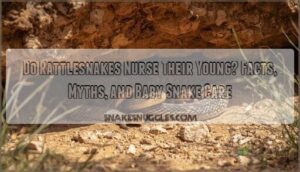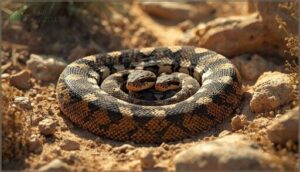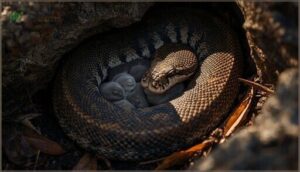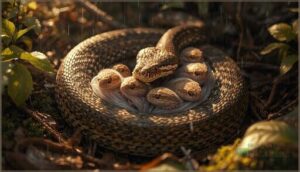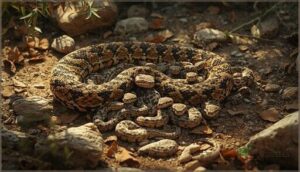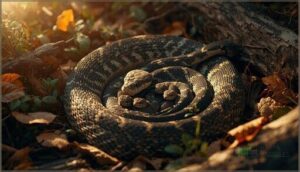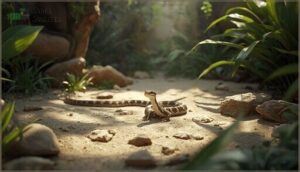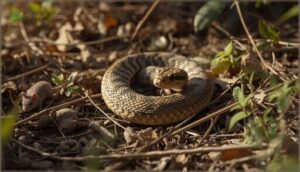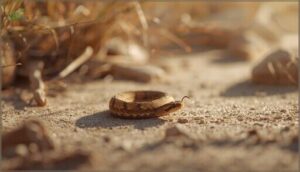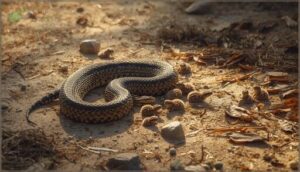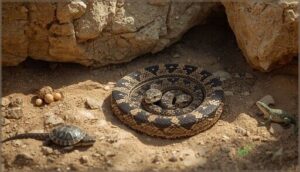This site is supported by our readers. We may earn a commission, at no cost to you, if you purchase through links.
You might hear stories of rattlesnakes sneaking into barns for a sip of milk or even nursing their babies under a shady rock, but these tales have no footing in the real world. Rattlesnakes, for all their reputation, parent in ways that set them apart from most reptiles, yet nothing about their care involves milk.
Their young arrive in the world ready to fend for themselves, armed with venom and little else. The real story of rattlesnake parenting reveals a survival strategy shaped by evolution—not by myth or folklore—where every newborn starts life with a toolbox fit for the wild.
Table Of Contents
- Key Takeaways
- Do Rattlesnakes Nurse Their Young?
- Why Rattlesnakes Cannot Produce Milk
- How Are Baby Rattlesnakes Born?
- What Maternal Care Do Rattlesnakes Provide?
- How Soon Are Baby Rattlesnakes Independent?
- What Do Baby Rattlesnakes Eat?
- Are Baby Rattlesnakes Born Venomous?
- How Do Baby Rattlesnakes Develop Their Rattle?
- Myths About Rattlesnakes Nursing
- How Rattlesnake Parenting Compares to Other Reptiles
- Frequently Asked Questions (FAQs)
- Do rattlesnakes nurse their young?
- Do snakes nurse their babies?
- Do rattlesnakes have babies?
- Do rattlesnakes nudge babies?
- Do rattle snakes look after their young?
- How long do rattlesnakes stay with their mother?
- How long do baby rattlesnakes stay with their mother?
- Do rattlesnakes care for their young?
- Do mother snakes feed their babies?
- Are there any snakes that care for their young?
- Conclusion
Key Takeaways
- Rattlesnakes do not and cannot nurse their young because they lack the anatomy and glands required to produce milk.
- Baby rattlesnakes are born live, not from eggs, and are ready to survive on their own from birth using their venom and instincts.
- Mother rattlesnakes provide brief protection and warmth to their young for about one to two weeks before the babies become fully independent.
- The myth that rattlesnakes nurse their babies comes from old stories, but science shows no reptiles have the ability to produce milk.
Do Rattlesnakes Nurse Their Young?
Ever wondered if rattlesnakes care for their babies the way mammals do? It’s a common question, probably fueled by old snake milk myths and nursing misconceptions seen in photos or stories. But rattlesnakes simply can’t nurse their young. This is a biological impossibility. Unlike mammals, they don’t produce milk, nor do they have the glands to do so.
Sometimes you might hear talk about “reptile lactation,” but that’s pure myth—no reptile, rattlesnake or otherwise, is capable of lactation. Rattlesnakes give birth to live young, and the idea of a mother snake providing milk is just another chapter in the evolving world of snake myths.
As ovoviviparous creatures, rattlesnakes actually give birth to live young. Evolution has simply taken reptiles down a different path.
Why Rattlesnakes Cannot Produce Milk
Rattlesnakes can’t make milk for their babies, no matter what stories you might hear. Their bodies are built differently from mammals, and that’s no accident of nature.
Here are the main reasons why these snakes aren’t equipped for nursing.
Absence of Mammary Glands
In Reptile Physiology, one fact stands out: rattlesnakes have no mammary glands. Their Snake Anatomy is built without the glandular structures needed for milk. Here’s what makes them different:
- Glandular Absence means no lactation.
- Mammal Distinction—only mammals make milk.
- Lack of milk production defines reptile lactation limits.
Rattlesnakes instead rely on internal nutrient stores. Snake milk myths simply aren’t true.
Comparison to Mammalian Nursing
Rattlesnakes simply can’t match the mammalian nursing process—no matter how closely you look. Mammals use mammary glands to produce milk, making Milk Composition the main tool for Parental Investment and Offspring Dependence.
In contrast, rattlesnakes lack lactation. They don’t nurse, cradle, or provide milk, and their young strike out on their own right away.
Scientific Consensus on Reptile Lactation
That’s the bottom line with reptiles: no mammary glands, no way to produce milk. Science backs it up, too. Reptile Milk Absence is a proven fact—from taxonomic reviews to studies on Reptilian Nutrient Transfer.
If you hear someone talk about Lactation Evolutionary Origins in snakes, know it’s just Debunking Nursing Myths. You can’t milk a snake.
How Are Baby Rattlesnakes Born?
Let’s talk about how baby rattlesnakes come into the world. Their birth story is pretty different from what you’d see with mammals or birds.
Here’s how the process really works, step by step.
Ovoviviparous Reproduction
Think of ovoviviparity as nature’s way of giving young snakes a head start. In rattlesnake reproduction, embryos develop inside their mother—nourished by yolk, protected from hazards. This strategy, common in ovoviviparous snakes, lets you see the benefits: adaptive advantages, safer Embryonic Development, and Neonate Hydration.
Clutch Size varies, but mom’s body is the nursery until birth.
Gestation Period and Birth Process
After spring, a female stores sperm and waits for just the right conditions. The rattlesnake gestation period—anywhere from four to seven months—lets embryos grow safely inside.
When birth timing aligns with warm weather and rain, she delivers live young, each one wrapped in a thin membrane. Neonate size? About 10–14 inches, ready to start life on their own.
Number of Offspring Per Clutch
When you look at how many live young emerge from a single rattlesnake reproduction event, numbers are all over the map. Clutch Size Factors and Species Variation play a big role. One litter might hold just a handful, another over two dozen. Here’s what shapes each clutch:
- Mother’s health and age
- Species and environmental conditions
- Reproductive Frequency
- Rattlesnake gestation period
- Neonate Survival odds
What Maternal Care Do Rattlesnakes Provide?
Rattlesnake mothers aren’t hands-off right away. In their own way, they stick around to help their young get a safe start. Here’s what that care usually looks like.
Protection From Predators
Picture a rattlesnake standing guard, muscles tense, ready to defend her young. Maternal defense is no idle threat: mothers pick hidden spots, rattle to scare off danger, and even strike when predators like rock squirrels close in. These defense mechanisms, from concealment strategies to active deterrence, boost baby rattlesnake survival rates when predators are on the prowl.
A rattlesnake mother fiercely guards her young, using concealment and warning rattles to boost their survival against prowling predators
| Maternal Defense | Concealment Strategy | Predator Profiles |
|---|---|---|
| Rattling, striking | Rocky crevices | Rock squirrels, hawks |
| Herding young | Dense vegetation | Coyotes, other snakes |
| Venomous bite | Camouflage | Birds of prey |
Keeping Young Warm
Keeping baby rattlesnakes warm is no accident—it’s a key part of maternal care. Rattlesnake mothers practice maternal thermoregulation by coiling around their offspring, acting as living blankets.
Because neonates can’t generate much endogenous heat, they depend on her for warmth, especially when ambient temperatures drop.
This behavioral strategy gives young snakes a head start in growth and survival.
Duration of Maternal Care
Just like a clock striking midnight, maternal care for baby rattlesnakes is short-lived—lasting only 1–2 weeks. This Care Duration Factors in temperature and the energetic costs on the mother. After their first shed, Post-Shed Dispersal kicks in.
While communal nesting offers warmth and safety, each mother’s parental care is strictly temporary, ensuring offspring quickly learn independence.
How Soon Are Baby Rattlesnakes Independent?
Baby rattlesnakes don’t stay with their mother for long. Once they shed their skin for the first time, they’re ready to start fending for themselves.
Here’s what you need to know about the enclosures that will help them take those first steps toward independence.
First Shed and Independence
Regarding baby rattlesnakes, that first shed marks a real turning point. After about 7 to 14 days, the baby trades its “button” for its first true rattle segment. Once shedding happens, you’ll notice:
- Juvenile behavior shifts toward exploration
- Independence timeline kicks in fast
- Maternal abandonment occurs, ending protection
- Rattle development begins for survival tactics
Early Hunting Abilities
As soon as that first shed is done, baby rattlesnakes get right to business. Their venom development is already sophisticated, and their strike accuracy is razor-sharp for such tiny hunters. With thermal sensing, they pick out the right prey and rarely miss.
Here’s how their skills stack up:
| Venom Development | Strike Accuracy | Prey Selection |
|---|---|---|
| Rapid | Impressive | Thoughtful |
| Potent | Reliable | Suited to size |
| Key to hunting | Boosts success | Ensures survival |
What Do Baby Rattlesnakes Eat?
Wondering what’s on the menu for a young rattlesnake? It all starts with what they get right after birth, and quickly moves to what they can find on their own.
Here’s what baby rattlesnakes eat as they grow.
Initial Nutrient Sources
For baby rattlesnakes, survival hinges on Yolk Sac Reserves. From the moment they’re born, these tiny snakes draw energy and nutrients from the yolk stored during Embryonic Development—a result of careful Maternal Investment.
This early phase, shaped by Neonatal Metabolism, lets each offspring fuel its growth and prepare for the shift to hunting without outside help.
Diet After First Shed
After using up their yolk stores, young rattlesnakes shift to a rodent-based diet—think mice and small mammals, depending on what’s around. This first feeding sparks a rapid Metabolic Increase; you’ll notice their Digestion Rate kicks in and they get warmer.
Their Feeding Frequency is low, but their bodies grow fast. Prey Selection shapes each baby rattlesnake’s early growth and habits.
Hunting Techniques of Young Snakes
Nearly every hunt by baby rattlesnakes follows the same playbook. First, you’ll see ambush predation: they wait motionless. Then, heat-sensing pits help them zero in on prey. Strike accuracy matters—one quick jab is all they get.
After that, prey selection and habitat selection influence survival tactics. Rattlesnake feeding habits truly depend on clever hiding and precise strikes.
Are Baby Rattlesnakes Born Venomous?
If you’ve ever wondered just how dangerous a baby rattlesnake really is, you’re not alone. These young snakes come into the world with some surprising abilities.
Here’s what you should know before we look at their enclosures.
Venom Potency in Juveniles
Did you know baby rattlesnakes pack a punch in a small package? Their venom toxicity per drop is higher than adults, thanks to differences in venom composition. It’s loaded with fast-acting proteins designed for prey immobilization.
That’s nature’s way of giving tiny venomous snakes like these an edge, even before they grow into their full power.
Effectiveness of Young Snake Bites
Imagine this: a young rattlesnake bites, and the outcome hinges on several unique details. While its Venom Yield is lower, changes in Venom Composition can make these bites unpredictable. Still, Bite Severity is rarely worse than adult bites in Pediatric Cases, and most respond well to Treatment Efficacy.
Consider these takeaways:
- Smaller Venom Yield
- Potent Venom Composition
- Variable Bite Severity
- Pediatric Cases often moderate
- High Treatment Efficacy
How Do Baby Rattlesnakes Develop Their Rattle?
When you think of a rattlesnake, the sound of its rattle almost always comes to mind. But baby rattlesnakes don’t arrive with a full-fledged rattle.
Here’s how that special feature starts to grow and change from day one.
Birth With a Button
You might be surprised to learn that baby rattlesnakes aren’t born with a rattle, but with a natal button. This single, rigid tip measures about 6 mm long and is composed of keratin. It contains two lobes—not enough to make noise.
The table below clarifies key features of this fascinating “button” birthmark:
| Feature | Natal Button | Mature Rattle |
|---|---|---|
| Size (approximate) | 6 mm long, 6.2 mm wide | Larger, multi-segment |
| Composition | Keratin | Keratin |
| Lobe Count | Two | Three per segment |
| Retention | Until first shed | Accumulates segments |
| Function | Silent marker | Audible warning |
Rattle Growth After Shedding
After a baby rattlesnake sheds its skin for the first time, it adds a new segment to its rattle. Each skin shed means another segment, so young snakes—who shed more often—grow their rattles quickly at first.
Rattle morphology, segment composition, and frequency of shedding reveal much about snake growth, but age estimation isn’t reliable since segments can break or be lost.
Myths About Rattlesnakes Nursing
You might hear a few tall tales about rattlesnakes caring for their babies in ways they simply can’t. Some myths stick around, even though the facts say otherwise.
Let’s clear up what’s real and what belongs in the storybooks.
Folk Beliefs and Misconceptions
Did you know stories about rattlesnakes that nurse their young aren’t just campfire talk? These myths trace back to ancient customs and milk symbolism, like offering milk to snakes for luck.
Today, you’ll find:
- Folk tales of snakes “stealing” milk from cows
- Misinterpreted behaviors mistaken for nursing
- Persistent beliefs despite clear scientific evidence that only mammals produce milk
Debunking Snake Milk Myths
It’s easy to see how tales about nursing behaviors in snakes grew legs—Cultural Origins go back centuries, and even the Milk Snake’s name stirs up curiosity.
Media Portrayals and Historical Accounts sometimes claim people can milk a snake or that rattlesnakes nurse their young.
But Scientific Rebuttals are clear: snakes can’t lactate or produce milk, and these stories are all myth.
How Rattlesnake Parenting Compares to Other Reptiles
Regarding how reptiles care for their young, there’s more variety than you might think. Rattlesnakes actually do a bit more than most other snakes.
Here’s how their parenting stacks up against the rest.
Reptilian Parental Care Strategies
Across the reptile world, parental care types range from nearly absent to surprisingly protective. Most reptiles, like many lizards and turtles, leave eggs to develop alone.
Snakes, including rattlesnakes, edge further; maternal care in reptiles takes the form of brief guarding or warmth, not nursing behaviors. Protective behaviors last only days, shaping survival strategies and influencing baby rattlesnake development.
Advantages of Rattlesnake Maternal Behavior
While most reptiles skip parenting, rattlesnake maternal care gives their young a real boost. Compared to solitary hatchlings, young rattlesnakes enjoy:
- Better offspring survival rates
- Stronger thermal regulation
- Coordinated predator protection through maternal defenses
- Smoother path to early independence, thanks to kin aggregation
These survival tactics of young rattlesnakes set them apart from others lacking such care.
Frequently Asked Questions (FAQs)
Do rattlesnakes nurse their young?
Imagine this: a mother rattlesnake, fierce and careful, wraps around her young—but she doesn’t nurse them. Despite old stories and the snake milk myth, rattlesnakes don’t produce milk. Lactation absence defines reptile nursing, not mammalian.
Do snakes nurse their babies?
Snakes don’t nurse their babies. They lack mammary glands, so true reptile milk or nursing behaviors never evolved. Snake lactation myths stem from stories, not science.
Instead, baby rattlesnakes are born independent, ready to hunt and survive alone.
Do rattlesnakes have babies?
Yes, rattlesnakes have babies—they give birth to live young rather than laying eggs. A single clutch size ranges from 8 to 15 offspring.
Birth season, neonate size, and reproduction frequency all shape their lifespan impact and parenting style.
Do rattlesnakes nudge babies?
Maternal nudging is part of rattlesnake nursing behavior. You’ll see a mother use her nose and body to herd and corral baby rattlesnakes, keeping neonates close for warmth, social aggregation, defensive attendance, and their early thermoregulation role.
Do rattle snakes look after their young?
Imagine a mother rattlesnake coiled around her newborns, guarding them from predators.
Rattlesnake parental care includes maternal care benefits—like keeping offspring warm and protected—until their first shed, improving survival rates despite limited extended family ties.
How long do rattlesnakes stay with their mother?
Rattlesnake maternal attendance lasts about one to two weeks, ending with post-shed dispersal.
During this time, baby rattlesnakes benefit from Rattlesnake parental care and communal nesting before independent survival becomes their key survival tactic in the wild.
How long do baby rattlesnakes stay with their mother?
Like a brief summer camp, maternal association length for baby rattlesnakes lasts just 7 to 14 days.
After their first shed, neonate independence timing kicks in, triggering post-shed dispersal, and the offspring set out alone—survival tactics in play.
Do rattlesnakes care for their young?
You might be surprised by how much parental care these snakes show. Maternal attendance duration lasts until the offspring finish their first shed, raising neonatal survival rates.
Defensive snake postures, postnatal energy stores, and even cooperative snake parenting support survival.
Do mother snakes feed their babies?
You won’t see nursing behaviors in snakes. Instead, babies rely on yolk reserves after birth, never receiving milk or meals from their mother.
Maternal instincts in Rattlesnakes focus on protection, not directly feeding young. Snake Feeding Habits begin independently.
Are there any snakes that care for their young?
Some snakes do show Snake Parenting. For example, pythons use Egg Brooding to protect developing eggs.
Rattlesnakes practice Maternal Defense, staying near their babies to guard them, boosting offspring survival.
Reptile Guardianship is usually brief.
Conclusion
Imagine, years from now, someone peeking into the tall grass and remembering that old rumor: “Do rattlesnakes nurse their young?”—and you’ll know why the answer matters.
The truth is simpler and more striking than any campfire myth. Rattlesnakes rely on ancient instincts, not milk, to prepare their young for independence. In the wild, survival hinges on the skills inherited at birth, not a parent’s nourishment.
What rattlesnakes teach is this: nature’s best lessons rarely follow old stories.
- https://www.reuters.com/article/fact-check/photo-does-not-show-rattlesnake-nursing-idUSL2N2L3284/
- https://sciencepress.mnhn.fr/sites/default/files/articles/pdf/az2017n1a6.pdf
- https://blog.nature.org/2019/07/09/timber-rattlesnakes-cool-facts-and-an-uncertain-future/
- https://pmc.ncbi.nlm.nih.gov/articles/PMC5312107/
- https://www.snakes.ngo/nurturing-rattlesnakes/

